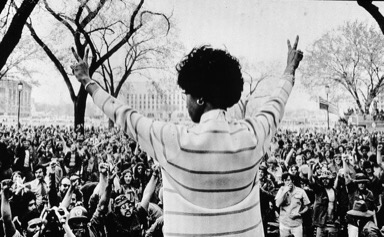Let's Talk Human Rights

Looking Back to Move Forward
By Paul Morrow
In March, US colleges and universities sent their students home early, echoing actions taken by many schools threatened by anti-war activism in the spring of 1970.
In April, newspapers and TV reporters announced that American fatalities from COVID-19 had surpassed total US service member deaths in Vietnam. Some reports spotlighted the toll the virus was taking on VA hospitals and Veterans Homes; others proposed public commemorations for victims.
Finally, in May, protests broke out nationally following revelations of police brutality and prosecutorial complicity in the deaths of George Floyd, Breonna Taylor, and Ahmaud Arbery. Floyd’s killing came just one week after the 50th anniversary of the May 15, 1970 police shootings of African American students and demonstrators at Jackson State University. As I write, local police and national guard members have returned to the streets of many American cities, and President Trump has called on the US military to “dominate” protestors.
Can we do more than identify parallels between events of the Vietnam era and our own time? Can we detect in current civil unrest direct legacies of the long 1960’s, in the form of divisions left unmended and calls for justice left unheard?
Over the past year, the Vietnam Legacies project at the Human Rights Center has studied the enduring effects of Vietnam-era activism and Cold War antagonisms in the US today. The role of race, links with the civil rights movement, and enduring gaps in written and visual recollections of the war emerge as themes that can illuminate our current experience.
Contemporary causes with clear roots in the Vietnam period include calls for African Americans to exercise their Second Amendment rights, which parallel the work of such mid-century groups as the Deacons for Defense and Justice, as well as vocal critiques of militarized policing, familiar from urban struggles of the 1960’s as well as campus protests at Kent State and elsewhere.
The relative absence of African Americans from both written and visual recollections of the impact of the conflict has received renewed attention in recent retrospectives on the Vietnam era. African Americans, we now know, filled a disproportionate number of frontline combat positions in Vietnam, and made up a disproportionate number of the casualties. Black legislators like Shirley Chisholm and Julian Bond offered searing condemnations of the war, its aims, and its expense. Yet the role of civil rights leaders and activists in the anti-war movement has often been forgotten, and the prominence of African American troops in combat operations and on casualty lists often overlooked.
April’s coronavirus milestone provided a natural experiment for assessing the presence of people of color in Vietnam War iconography. In a sample of fifty photographs and stills featured alongside news items documenting the fact that American COVID-19 deaths had surpassed Vietnam War fatalities, only two clearly depicted African American service members. One of these was an image of Frederick Hart’s statue The Three Soldiers, located near Maya Lin’s Wall on the National Mall. As Patrick Hagopian - a historian of the Vietnam conflict - points out, Hart’s original concept for a memorial sculpture did not include an African American soldier, and the finished composition conceals a “sustained period of wrangling about the ethnic roles the statue depicted.”
Visual depictions of America’s past deeply concern today’s activists, as evidenced by Alabama demonstrators’ efforts to remove Birmingham’s statue of Jefferson Davis. It is timely that Americans will soon be able to watch a Vietnam War film that places the experiences of Black soldiers front and center. Spike Lee’s Da 5 Bloods, due out June 12 on Netflix, tells the story of four African American veterans who return to Vietnam in the present day and confront unresolved issues from their service. Lee, whose early film Do the Right Thing centers directly on riots in Brooklyn’s Bedford-Stuyvesant neighborhood after an incident of police brutality, has also recently released a short film memorializing George Floyd’s death. As he notes, “I’ve seen this before. This is not new [...] People are tired and they take to the streets.”
Da 5 Bloods represents a kind of visual intervention: a change in the kinds of visual encounters that individuals can experience, which aims at transforming their historical understanding and their political commitments. The removal of confederate statues in Birmingham, New Orleans, and other Southern cities over the past several years can also be considered a visual intervention, as can the creation of the National Museum of African American History and Culture in Washington D.C.
What these interventions have in common is the conviction that how people see the past affects how they think about the present, and how they envision the future. Such a conviction, and such efforts, are of fundamental importance as we try to see our way out of the entrenched inequalities and deep divisions of American society today.
Dr. Paul Morrow is the John M. Meagher Human Rights Fellow at the University of Dayton Human Rights Center.
Photo credit: New York Times Co./Mike Lien/Getty Images
